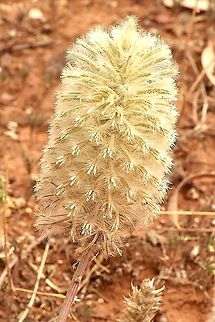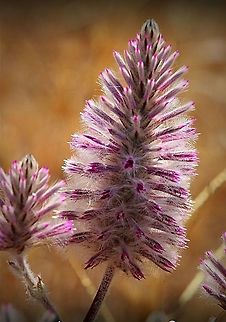Regal foxtail
Ptilotus nobilis
''Ptilotus nobilis'', commonly known as yellow tails, regal foxtail or broad foxtail is a perennial herb of the family Amaranthaceae. It is found across dry interior areas of mainland Australia.
The species was first formally described by English botanist John Lindley in Thomas Mitchell's ''Three Expeditions into the interior of Eastern Australia'' in 1838. Lindley gave it the name ''Trichium nobile''. The species was transferred to the genus'' Ptilotus'' in 1868 by Victorian Government Botanist Ferdinand von Mueller in the sixth volume of his ''Fragmenta Phytographiae Australiae''. A 2007 genetic study focusing on populations of ''P. nobilis'' and the pink-flowered ''Ptilotus exaltatus'' found a very close relationship between the two. ''Ptilotus exaltatus'' has since been synonymized under ''P. nobilis'' subsp. ''nobilis''.
''Ptilotus nobilis'' grows to around 1 metre high, with an erect perennial habit. Its spoon-shaped leaves are up to 13 cm long, and 5 cm wide, arranged alternately along the stems. The flowers rise above the foliage and are cylindrical fuzzy green-yellow spikes up to 22 cm high and 5 cm wide. Plants studied at Cunnamulla in South West Queensland had both purplish and greenish flowerheads; this was a zone of overlap between the ''P. nobilis'' and ''P. exaltatus'' populations.
Scattered across inland New South Wales, it grows on a range of soils, though prefers more sandy than clayey soils. Habitats include ''Acacia'' woodland, mallee, shrubland and grassland.
''Ptilotus nobilis'' subsp. ''nobilis'' is listed as "endangered" on the Department of Sustainability and Environment's ''Advisory List of Rare Or Threatened Plants In Victoria''.
Cultivars developed and registered by Dion Harrison and colleagues at the University of Queensland include 'Passion' , 'Poise' , and 'Purity' .
The species was first formally described by English botanist John Lindley in Thomas Mitchell's ''Three Expeditions into the interior of Eastern Australia'' in 1838. Lindley gave it the name ''Trichium nobile''. The species was transferred to the genus'' Ptilotus'' in 1868 by Victorian Government Botanist Ferdinand von Mueller in the sixth volume of his ''Fragmenta Phytographiae Australiae''. A 2007 genetic study focusing on populations of ''P. nobilis'' and the pink-flowered ''Ptilotus exaltatus'' found a very close relationship between the two. ''Ptilotus exaltatus'' has since been synonymized under ''P. nobilis'' subsp. ''nobilis''.
''Ptilotus nobilis'' grows to around 1 metre high, with an erect perennial habit. Its spoon-shaped leaves are up to 13 cm long, and 5 cm wide, arranged alternately along the stems. The flowers rise above the foliage and are cylindrical fuzzy green-yellow spikes up to 22 cm high and 5 cm wide. Plants studied at Cunnamulla in South West Queensland had both purplish and greenish flowerheads; this was a zone of overlap between the ''P. nobilis'' and ''P. exaltatus'' populations.
Scattered across inland New South Wales, it grows on a range of soils, though prefers more sandy than clayey soils. Habitats include ''Acacia'' woodland, mallee, shrubland and grassland.
''Ptilotus nobilis'' subsp. ''nobilis'' is listed as "endangered" on the Department of Sustainability and Environment's ''Advisory List of Rare Or Threatened Plants In Victoria''.
Cultivars developed and registered by Dion Harrison and colleagues at the University of Queensland include 'Passion' , 'Poise' , and 'Purity' .

